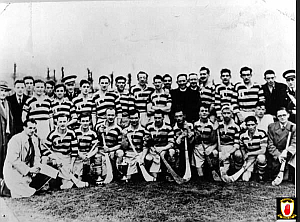|
 |
Na Piarsaigh H&F Club
Birth of a Club..

These young schoolboys influenced by their education at North Mon. had a great love for our national culture and games. They felt, and with some justification, that existing clubs, and indeed the GAA itself, were not aspiring to the founding ideals of the Association. They set about change and an informal meeting was held under a lamppost outside No.3 (St.Ita's) Redemption Road. Amongst the attendance were: Derry Terry, Christy Twomey, Liam Connery, Pat Leary, Rev. McCabe, Romey Sullivan, Bertie Dorgan, Theo Dorgan, Sean McAiliffe, Paddy Sutton, Jimmy Keating, Paudie Collins, Joe Murphy, Bernie Murphy, Sean Corkery.
In an effort to become properly organised the first formal meeting was held in the presbytery of the North Cathedral. Meanwhile, the youthful members in an effort to achieve higher status and greater influence called upon one of their teachers, Donnacha o Murchu, for guidance and assistance. This led to him becoming the first Uachtaran Donnacha O Murchu, Runai Derry Terry, Cisteoir Paddy Sutton.
In choosing a name for the club the members sought one which would reflect their aims and ideals. Padraig Pearse, it was felt, because of his underlying love of Ireland and all things Irish, reflected those ideals admirably. Thus the name "Na Piarsaigh" was adopted.
A set of playing-gear colours (black and amber) was acquired. Later in 1951 the symbolic red hand of Ulster with severed thumb was selected as the club crest after careful consideration. The red hand represents the island that is Ireland, the severed thumb our six north-eastern counties still under foreign rule. The legend is that when Ireland is united the thumb will again rejoin the fingers to create a strong and useful hand.
The newly-formed club, as part of its policy, decided to conduct its affairs as far as possible through the medium of Irish. Indeed the policy extended to the field of play where the players addressed one another in our native tongue. So novel was this approach to GAA affairs that it led to a certain amount of resentment amongst other clubs. The national outlook was then in such a state during what is termed the "Emergency" that any willingness to promote Irish language culture generally met with strong opposition. The opposition to club activities by the local clergy, in fact, caused us to lose the use of St. Mary's Hall.
In relation to this the then Uactaran Donnacha O Murchu recalls the words of a prominent local clergyman of the day, "We don't want any of that oul' stuff going on here". This, however, did not unduly upset our youthful members who strove all the more to achieve their aims and ideals. By 1946 the membership had grown from thirty to seventy, but, as yet the club had failed to win a title in either hurling or football. However, in the same year the City Division Junior Hurling Championship was won, a historic first and no mean achievement in three years of existence. During this period also, minor teams were fielded but without much success. Training for matches was a problem without a club ground. During this period training took place in such diverse locations as the Lee Fields, Rivers town, The Fair Field, and Browns Field, which was located near the present day Church of the Ascension in Gurranabraher.

AQUISITION OF CLUB GROUNDS..
As the club grew and expanded in the late forties, the need for a playing field was keenly felt and expressed by the then Secretary Donncha O Griofa in his annual report of 1951 when he wrote: "The lack of a playing field of our own is greatly impeding the advancement of our teams. As members are unable to get sufficient training for matches, they ultimately wander to other codes".
This appeal by the Secretary was to bear fruit six years later when after hard years of fund-raising the club purchased a field at The Commons, Fair Hill. In this eventful year of 1951 the need for a properly organised minor section was strongly mooted. Again, Donncha O Griofa, in his address, referred to this when he wrote: "Films and books cannot teach the game. Give young boys hurleys and footballs and they will do the rest. Encourage them to think they are the coming champions. The success of our club must ultimately rest in the generation to follow".

SUCCESS ON THE PLAYING FIELDS..
In 1946 the Club won its first title at Junior level, annexing the City title. However this group of dedicated workers and followers had to wait until 1953 to achieve their finest hour, when the County Junior Hurling title was added.
Three Minor Hurling County titles were added in 1961, 62 and 63, in what should have laid the foundations for success at senior level. However disappointment was to follow with heartbreaking defeats in the mid sixties.
In football success at Junior level came with victory in the County final in 1964, followed quickly by County success at Intermediate level the following year. Thus the Club had gone from Junior level to Senior in the shortest possible period.
However it was to be the seventies in which much of the groundwork for todays success at senior level was laid with a succession of brilliant hurling teams at under age level.

|
|

